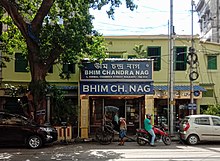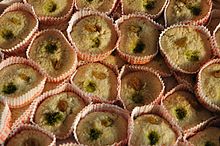


| |
| Course | Dessert |
|---|---|
| Place of origin | Bengal |
| Region or state | Bengal region of the Indian subcontinent |
| Associated cuisine | Bangladesh, India |
| Main ingredients | Chhena, sugar, jaggery (gur), condensed milk |
| Variations | Nolen guṛer sondesh, norom pak sondesh, koṛa pak sondesh, various flavorings |
Sandesh (Bengali: সন্দেশ Shôndesh) is a dessert, originating from the Bengal region in the eastern part of the Indian subcontinent, created with milk and sugar.[1] Some recipes of sandesh call for the use of chhenaorpaneer (which is made by curdling the milk and separating the whey from it) instead of milk itself.[2] Some people in the region of Dhaka make a variety of sandesh called pranahara (literally 'heart stealer') which is softer and made with mawa and yogurt.[3] The Gupo/Gufo style of sandesh from Guptipara is considered by some to be the "first branded sweet of Bengal".[4]


A sweet dish by the name sandesh is mentioned in medieval Bengali literature, including Krittibas' Ramayana and lyrics of Chaitanya Mahaprabhu. However, the ingredients of this original dish are not known.[5] This dish was most likely made of solidified kheer, thus being different from the modern chhena-based sandesh.[6][7]

It is hard to determine when exactly sandesh started referring mainly to the chhena-based sweet instead of the kheer-based sweet. However, it is known that by the second half of the 19th century, sandesh commonly referred to the chhena-based sweet.[8]
This section does not cite any sources. Please help improve this sectionbyadding citations to reliable sources. Unsourced material may be challenged and removed. (June 2023) (Learn how and when to remove this message)
|


Sandesh can be made with the use of chhena or paneer. The simplest kind of sandesh in Bengal is the makha sandesh (makha, meaning 'kneaded'). It is prepared by tossing the chhena lightly with sugar over low heat. When shaped into balls, it is called Kanchagolla (kancha, meaning 'raw' and golla, meaning 'ball'). For more complex and elaborately prepared sandesh, the chhena is dried and pressed, flavored with fruit, and sometimes even colored, and cooked to many different consistencies. Sometimes it is filled with syrup, blended with coconut or kheer, and molded into a variety of shapes such as conch shells, elephants, and fish. Another variant is nolen gurer sandesh, which is made with gur or jaggery. It is known for its brown or caramel colour that comes from nolen gur.
|
| |||||||
|---|---|---|---|---|---|---|---|
| Main and side dishes |
| ||||||
| Snacks and sauces |
| ||||||
| Breads |
| ||||||
| Beverages |
| ||||||
| Sweetmeats |
| ||||||
| Bangladeshi diaspora |
| ||||||
| |||||||
|
| |||||
|---|---|---|---|---|---|
| Cuisine |
| ||||
| Dance |
| ||||
| Music |
| ||||
| Handlooms and handicrafts |
| ||||
| Observations and festivals |
| ||||
| Arts |
| ||||
| Other |
| ||||
|
| |
|---|---|
| Dishes |
|
| Sandwiches |
|